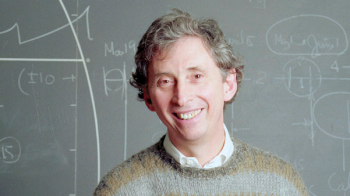
Experimental particle physicist and founder of antiproton physics in Czechoslovakia (later the Czech Republic), Vladislav Šimák, passed away on 26 June 2019. Since the early 1960s his vision and organisational skills helped shape experimental particle physics, not only in Prague, but the whole of the country.
After graduating from Charles University in Prague, he joined the group at the Institute of Physics of the Czechoslovak Academy of Sciences studying cosmic rays using emulsion techniques, earning a PhD in 1963. Though it was difficult to travel abroad at that time, Vlada got a scholarship and went to CERN, where he joined the group led by Bernard French investigating collisions of antiprotons using bubble chambers. It was there and then that his lifelong love affair with antiprotons began. He brought back to Prague film material showing the results of collisions of 5.7 GeV antiprotons and protons from a hydrogen bubble chamber, and formed a group of physicists and technicians, involving many diploma and PhD students who processed them. Vlada also fell in love with the idea of quarks as proposed by Gell-Mann and Zweig, and was the first Czech or Slovak physicist to apply a quark model to pion production in proton–antiproton collisions.
In the early 1970s, when contacts with the West were severely limited, Vlada exploited the experiences he accumulated at CERN and put together a group of Czech and Slovak physicists involved in the processing and analysis of data from proton–antiproton collisions, using the then-highest-energy beam of antiprotons (22.4 GeV) and a hydrogen bubble chamber at the Serpukhov accelerator in Russia. This experiment, which in the later stage provided collisions of antideuterons with protons and deuterons, gave many young physicists the chance to work on unique data for their PhDs and earned Vlada respect in the international community.
After the Velvet Revolution he played a pivotal role in accession to CERN membership
In the late 1980s, when the political atmosphere in Czechoslovakia eased, Vlada together with his PhD student joined the UA2 experiment at CERN’s proton–antiproton collider, where he devoted his attention to jet production. After the Velvet Revolution in November 1989 he played a pivotal role in the decision of the Czech and Slovak particle-physics community to focus on accession to CERN membership.
In 1992 Vlada took Czechoslovak particle physicists into the newly formed ATLAS collaboration, and in 1997 he joined the D0 experiment at Fermilab. He was active in ATLAS until very recently, and in 2014, in acknowledgment of his services to physics, the Czech Academy of Sciences awarded Vlada the Ernst Mach Medal for his contributions to the development of physics.
Throughout his life he combined his passion for physics with a love for music, for many years playing the violin in the Academy Chamber Orchestra. For many of us Vlada was a mentor, colleague and friend. We all admired his vitality and enthusiasm for physics, which was contagious. Vlada clearly enjoyed life and we very much enjoyed his company.
He will be sorely missed.








